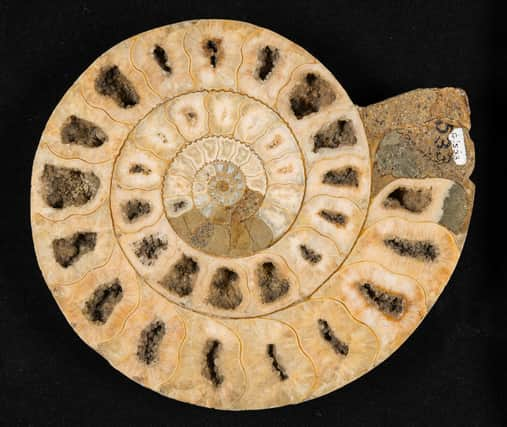How Scotland's fossils help us understand life on earth


As the project curator investigating Scotland’s fossil collections, I expected to cover quite some distance. Looking back over the last two years, I realise I have not only travelled back and forth across the country but also through time.
I have seen an extraordinary range of fossils at 70 museums and together they tell the very long story of Scotland and the life that inhabited it over the many years of geological time.
Advertisement
Hide AdAdvertisement
Hide AdMost remarkable is the great diversity of fossils from such a long time ago. In the Silurian period (443-420 million years ago) the area around Lesmahagow in Lanarkshire and Muirkirk in Ayrshire was underwater. This was inhabited by primitive, jawless fish like Birkenia, Lasanius and Jamoytius kerwoodi that used suction to feed.
Scotland in the Devonian period (419-358 mya) was an area of dry, barren desert with fossils providing evidence of water. The Lower Devonian Rhynie Chert preserves the earliest known ecosystem with early land plants, insects and millipedes living around hot pools of bubbling silica-rich water.
In the Middle Devonian, a large lake system extended from Moray to Orkney with a network of rivers feeding it from Shetland. This was inhabited with the greatest diversity of fish yet: acanthodians, osteolepids, lungfish, heavily armoured placoderms and the unusual eel-like Palaeospondylus.
In the Carboniferous period (358-298 mya), vertebrates were following plants and arthropods out of the water onto land. How they evolved to do this was a mystery until recently but since 2008, vertebrate fossils from the Lothians and Scottish Borders have filled the gap. The amphibian Pederpes, which is on display in The Hunterian, is one of a number of lumbering animals that inhabited thickly vegetated, humid swamps.
The Permian period in Scotland (298-251 mya) followed more continental collisions with the lower Permian near Dumfries and along the Moray Coast known for footprint and trackway trace fossils.
These are evidence of reptiles walking, running and burrowing in shifting dunes in surprising abundance but all of these animals were lost soon after in an extinction known as the ‘Great Dying’.
Fossils from the Jurassic period (201-145 mya) demonstrate how herbivorous and predatory dinosaurs wandered in search of food. They left trackways in soft mud and the various shapes and sizes can be seen in displays at the Staffin Dinosaur Museum and The Hunterian.
Some of the footprints represent the earliest evidence of dinosaurs in Scotland.
Advertisement
Hide AdAdvertisement
Hide AdExplosive volcanic activity as the North Atlantic opened then followed. A rare and important discovery was the Paleocene period’s (66-56 mya) Ardtun Leaf Beds on the Isle of Mull which somehow survived the heat of lava and ash.
The final stop on our fossil journey, at the very top of this geological stack, are the 13,000-year-old Arctic clays, found along the Tay and Clyde Estuaries. Fossils include molluscs, fragile brittle stars, barnacles and microfossils as well as rare vertebrate bones from seals and an eider duck.
Studies of the fossils and clays document the northward shift of cold zones as glaciers retreated after the last Ice Age and are still very relevant to climate change today.
Dr Sue Beardmore reviewed Scotland’s 250,000-strong fossil collection in a project funded by John Ellerman Foundation.
A message from the Editor:Thank you for reading this article. We're more reliant on your support than ever as the shift in consumer habits brought about by Coronavirus impacts our advertisers.
If you haven't already, please consider supporting our trusted, fact-checked journalism by taking out a digital subscription.
Comments
Want to join the conversation? Please or to comment on this article.